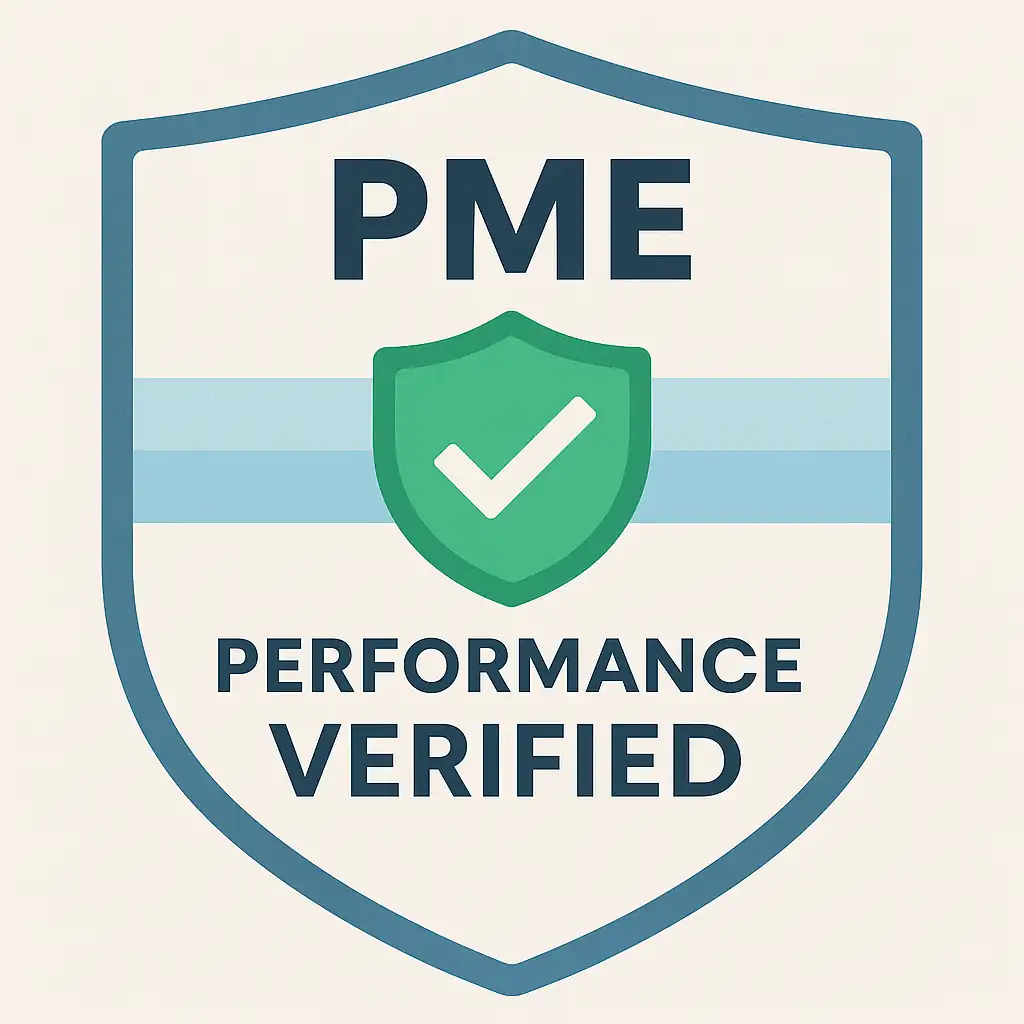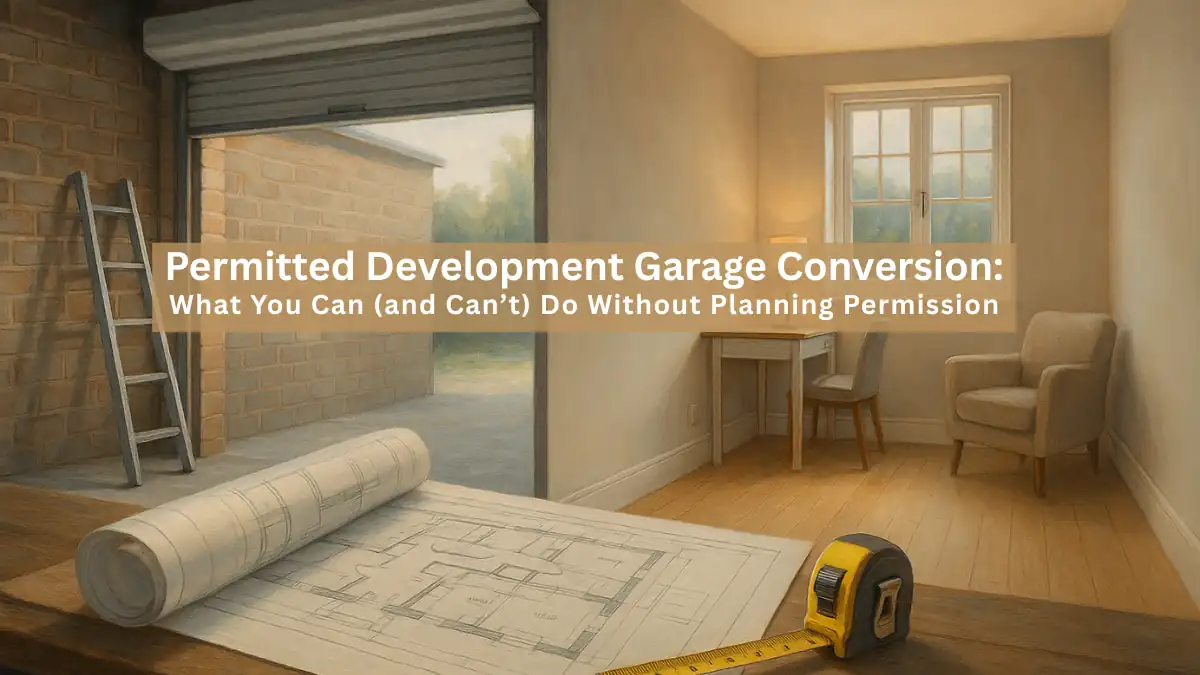Share this post:
Converting your garage under Permitted Development?
We’ll check your address, constraints and drawings against PD rules so you can move forward with confidence.
At-a-glance: Permitted Development for Garage Conversions
Under UK Permitted Development (PD) rights, many homeowners can convert an attached or integral garage into a habitable room without a full planning application—provided you don’t enlarge the building and you meet the specific PD rules and Building Regulations standards. You’ll still need compliant drawings, and we strongly recommend a Lawful Development Certificate for certainty if you sell or remortgage. This guide covers the limits, costs, process and common mistakes—written for UK homeowners.
What “Permitted Development” Means for Garage Conversions
Permitted Development grants certain building works that can be carried out without a full planning application. For attached or integral garages, you can usually convert the internal space to a habitable room—e.g., a home office, playroom or snug—if you stay within the PD rules, the existing envelope, and Building Regulations. Changing the use from parking/storage to living space is often acceptable under PD because it’s an internal conversion rather than an external enlargement.
Even if planning permission isn’t required, lenders, buyers and insurers will want assurance that the conversion is lawful and built to regulation. That’s where drawings, a Building Control route, and—ideally—an LDC come in.
Is Your Garage Likely Eligible? (Quick Checks)
- It’s part of the original house: Conversions are simpler when the garage is original, not a later addition with conditions attached.
- No enlargement: You’re not projecting beyond the existing walls or roof (internal conversion only).
- No Article 4 Direction: Your area hasn’t removed PD rights (common in conservation areas or certain streets). Your council’s website can confirm.
- No specific planning condition: Past approvals may include a condition to retain parking or keep the garage for vehicle use—this blocks PD until varied or removed.
- Parking impact manageable: Some councils expect you to maintain an acceptable level of off-street parking on the plot.
Key PD Limits & What You Can’t Do
With PD, you’re generally converting within the existing shell. That means:
- No enlargement: No front extension or extra volume. Replacing the garage door with a wall/window is usually fine, but adding a bay that projects beyond the existing plane can trigger planning.
- Respect the street scene: New front elevation should be sympathetic (materials, proportions). Overbearing changes can be challenged.
- Windows & privacy: Side windows near boundaries need careful placement to avoid overlooking issues.
- Change of use vs. conversion: Internal conversion is typically PD; creating a separate dwelling is not PD.
- Conditions override PD: If a past consent says “garage shall be retained for parking”, PD can’t be used unless that condition is varied.
Should You Get a Lawful Development Certificate?
A Lawful Development Certificate (LDC) is an optional application to your council that confirms—in writing—that your garage conversion did not require planning permission. It’s extremely useful for:
- Resale and remortgage: Buyers and lenders love certainty.
- Dispute protection: If neighbours or enforcement raise concerns, your LDC is your shield.
- Paper trail: It locks in the “lawful” status for the future.
Building Regulations Still Apply
PD is about planning permission. It does not relax Building Regulations. A garage becomes habitable space only when it meets standards for:
- Structure: Lintels for the former garage opening, any load-bearing alterations, floor upgrades, possible localised foundations.
- Thermal performance (Part L): Insulation to walls, floor, roof; upgraded doors/windows; thermal bridging treated.
- Fire safety (Part B): Escape routes, doors, detection, potential upgrade of internal linings depending on adjacency to the drive/street.
- Ventilation (Part F): Background and extract ventilation to prevent condensation and poor air quality.
- Sound (Part E): Internal sound separation where adjoining neighbours or noisy rooms.
- Electrics (Part P): Domestic electrical work must be certified.
- Drainage (Part H): If you’re adding a WC/utility, foul and surface water routing must be correct.
Choose either Full Plans Building Control approval (drawings checked before work) or Building Notice (faster, fewer upfront drawings, but more on-site scrutiny). For most homeowners, Full Plans gives smoother construction and fewer surprises.
Not sure if your idea fits Permitted Development?
We’ll check your project against PD rules and let you know if you need a full planning application.
Costs & Typical Timelines
Timeline: Design & approvals ~2–6 weeks (longer if seeking an LDC); construction ~2–6 weeks depending on scope and trades availability.
Step-by-Step: How to Convert a Garage Under PD
| Step | What to Do | Why It Matters |
|---|---|---|
| 1. PD & Constraints Check | Confirm no Article 4; review historic conditions (e.g., “retain garage for parking”). | Avoids breaching withdrawn PD rights or restrictive conditions. |
| 2. Measured Survey | Capture accurate dimensions, levels, openings, structure and services. | Good drawings reduce surprises and speed approvals. |
| 3. Concept & Drawings | Prepare existing/proposed plans, elevations & details for Building Control/LDC. | Clear, compliant plans guide the build and de-risk inspections. |
| 4. Building Control Route | Choose Full Plans or Building Notice; lodge documents; book inspections. | Legal requirement; ensures structure, fire, thermal, ventilation compliance. |
| 5. Optional LDC | Submit an LDC application to confirm no planning permission required. | Provides documentary proof for lenders and future buyers. |
| 6. Construction | Form new insulated wall/infills; lintel support; floor/roof insulation; services. | Builds a warm, safe, habitable room that meets regulations. |
| 7. Sign-off & Records | Obtain completion certificate; keep drawings, certificates, LDC if obtained. | Critical for resale, remortgage and peace of mind. |
Common Pitfalls & Gotchas
- Front elevation mis-match: A crude brick infill where a quality façade treatment was expected can trigger enforcement or refusal on LDC if it looks like an enlargement/change beyond PD intent.
- Poor insulation spec: Cold floors and walls make the room unusable. Meet or exceed Part L to avoid condensation and bills.
- Unsupported opening: Removing the garage door frame without a proper lintel is a structural risk.
- Overlooking & noise: New side windows near boundaries can cause neighbour complaints—design carefully.
- Skipping the paper trail: No Building Control completion certificate and no LDC can delay sales and remortgages.
Technical Details (Insulation, Fire, Structure, Drainage)
Thermal Upgrades
Expect to add insulated wall build-ups to the garage door infill and any single-skin walls, rigid floor insulation (or retrofit solutions if floor depth is limited), and roof/ceiling insulation. Treat cold bridges at thresholds and connection points.
Fire & Escape
Provide smoke detection and maintain a safe escape route. If the new room forms part of the main living space, door ratings and separation may need upgrading depending on layout and storey count. Garages that adjoined habitable rooms may have needed separation—when converting, confirm the new arrangement meets Part B.
Structure
Most conversions need a lintel over the former garage opening. If you’re altering internal load-bearing walls or inserting steels, a structural engineer design and calcs will be required for Building Control.
Ventilation
Provide adequate background ventilation (trickle vents) and consider mechanical extract if you’re forming a shower/WC or utility. Manage vapour with proper membranes and detailing.
Drainage & Services
For new WCs/utility points, confirm foul drainage routes. Check for build-over issues if near a public sewer. Coordinate electrics (Part P), heating extensions and controls early.
FAQs: Permitted Development Garage Conversion
Do I need planning permission to convert an attached garage to a room?
Often no, if you’re staying within the existing envelope and no conditions remove PD rights. However, you must still meet Building Regulations, and an LDC is wise for proof. If a past planning condition requires the garage to remain for parking, you’ll need planning or to vary that condition.
Can I replace the garage door with a wall and window?
Yes, typically under PD, but keep materials and proportions sympathetic to the house. An obvious “patch” can look poor and risk objections or an LDC refusal. Good drawings and detailing help.
Will I lose parking and get refused later?
Some councils are sensitive to on-plot parking. If off-street parking is already limited, your PD rights may be removed by condition or Article 4. We’ll check your site and history beforehand.
Is Building Control mandatory?
Yes. PD doesn’t bypass Building Regulations. Choose Full Plans (recommended) or Building Notice. Keep your completion certificate with your property records.
How much does a garage conversion cost?
Very broadly: £10k–£25k+ build cost depending on spec and services; design/drawings typically £650–£1,500+; Building Control fees ~£500–£1,000+. Adding a WC/utility, structural steel or premium glazing increases cost.
Will it add value?
Usually yes—especially for homes where a warm, light room is more useful than seldom-used parking. Local market conditions apply; a well-designed conversion with paperwork in order is far more attractive to buyers.
Want certainty on drawings, Building Control and LDC?
We prepare compliant plans and handle submissions so you don’t have to juggle the paperwork.
Next Steps & Useful Guides
- Ask for a PD check: We’ll confirm eligibility, history and any conditions.
- Book a measured survey: Accurate drawings de-risk cost and time.
- Choose your approval route: Building Control (Full Plans recommended) and optional LDC.
- Build with confidence: We can liaise with your contractor through to completion.
You might also find these helpful
- Garage Conversions (Pillar Guide)
- Planning Permission: UK Homeowner Guide
- Building Regulations: What Applies to Home Projects
- Retrospective Building Regulations: Time Limits & Regularisation
- Party Wall: When You Need to Notify Neighbours
- Extension Costs: Budgeting the Big Items
- Building Over or Near a Sewer: What to Know
External Guidance
Ready to move your project forward?
Plans Made Easy can prepare compliant plans, manage submissions, and guide you from idea to approval.

Performance Verified ✅
This page meets PME Optimisation Standards — achieving 95+ Desktop and 85+ Mobile PageSpeed benchmarks. Verified on


